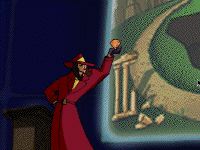





|
Review of
Carmen Sandiego Math Detective
 Published by: Brøderbund
Published by: Brøderbund
Age Range: 8-14
Year: 1998
Platform information: Mac or PC
Reviewer: Brian King and Megan Murray
Image © Brøderbund. Used with permission.
Is the Game Mathematical?
There are five math activities in Carmen Sandiego: Math Detective. These activities span the range from fairly good to not much more than drill and practice. On one end is the Light Spectrometer. You must move bars that are labeled with whole numbers, fractions, decimals, and/or percents into a column so that they are in order from smallest to largest. This activity requires planning, strategy, and logicand content such as equivalencies among fractions, decimals and percents, place value, and the the number system. Another interesting activity is the Molecular Scope. In this crossword-like game you must choose a line of circles to fill, read the accompanying word problem, translate it into a number sentence, and type it into the empty circles. The word problems require careful reading and interpretation -- what information is important? what is irrelevant? what operation might be required? what information do I already have from previously solved equations?
The Crime Wave Sensor gives the player five successive tries to determine the exact value of a number missing from a traditional equation (i.e., 25 + __ = 73). You select an answer from a set of 50 possible solutions (i.e., the numbers from 2 through 51). The game tells you if the guess is too high (or low) and then eliminates all the answers that are greater than (or less than) your guess. This activity encourages players to use multiple strategies, refine their estimates over time, and learn about numbers and operations. However, it is also really easy to just guess numbers at random as the game then limits the number of possible solutions. Also, in this context there is little reason to estimate. In the real world estimation is a powerful tool for approximating an answer. These problems are not complex enough to warrant estimating, and the actual goal is to find an exact value.
The Atom Smasher gives you three minutes to solve ten multiple choice computation problems, and the choices often include answers that are the results of common errors. However, this activity, which appears twice per level, quickly becomes mind-numbing as you try to progress through the 12 levels to save all the wonders of the world. Although the Microchip Decoder allows for the constructions of lines, angles and shapes, it is very limited. Most often the player is asked to connect points on a grid, and then answer a multiple choice question about the resulting figure (such as "what is the name of the shape you have just drawn?"). The game focuses heavily on vocabulary, which, like the mathematics in some other areas, the player needs to have already learned outside of the game in order to play successfully. Carmen Sandiego includes a glossary, but looking up a new definition becomes tedious as the definition for one term often uses vocabulary that requires further research.
Is the Game Equitable?
Although past Carmen Sandiego games (such as Where in the World is Carmen Sandiego?) have proven to be popular with a diverse audience, I suspect Carmen Sandiego: Math Detective will fail to be as popular as its geographical counterparts. It is difficult to invest in the fantasy of the narrative as you endlessly search numerous hideouts for the same five math games. This game seems to think itself an adventure-style game, where you navigate through time and space, find objects and clues, and use them to your advantage. The problem is, all of the searching in Carmen Sandiego: Math Detective is artificial. You quickly learn that, for example, there are two (or three) hideouts per level and that the "clues" are equally spread out among them. Although there is a radar which watches for approaching criminals (who get closer with each finished puzzle), they never arrive until you have found all the clues in a location and are leaving the building. Although you receive email from Chase Deveneaux(which you cannot answer or respond to), occasionally hear from Carmen, and see "criminals" as you "escape" each hideout, the interactions feel artificial.
Is the Game a Good Game?
The graphics, while beautiful, become tedious. The player must search isolated cavernous hideouts that provide very little interaction. "Searching" requires scanning objects in the room with the mouse until the cursor becomes large and flashes, indicating you've "found" another math game. The graphics are so ornate and detailed that they make basic manipulation of the game time consuming and tedious. Simply choosing an activity (such as entering an activity, searching a new hideout, or hearing a voicemail) requires wait time as all the bells and whistles of the game kick in. These aspects discourage investment in the narrative and the game.
The challenges presented by some of the mathematics are appropriate, and players can investigate each puzzle individually through the Options menu. However, it is difficult to remain engaged with the mathematics. While some players might be motivated by the report card-like progress report which can be printed out at any time, we can't imagine the math activities holding interest or attention for the copious amounts of time it would require to save all twelve wonders of the world. (To get through the game you must play the same five puzzles over and over again.) Carmen Sandiego: Math Detective might be a nice escape from the classroom, but it's not for recess.

Back to the top of the page
|



